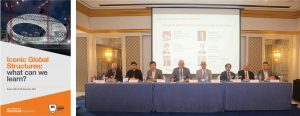The last great international conference … that I attended
During the last two days of September 2019, a group of internationally renowned structural engineers, along with their architectural (or other-related-industry) cohorts, assembled in Dubai to share experiences in building some of the world’s most iconic structures.
The Iconic Global Structures – what can we learn? Conference was the successful inaugural event jointly organized by IStructE and SEI/ASCE. It aimed to promote an international exchange of essential lessons learned within the structural engineering profession. It was awesome. For those who missed it, a post-conference summary report is freely available at www.asce.org/SEIGlobal.

(left) Iconic Global Structures – what can we learn post-conference summary document. Available at www.asce.org/SEIGlobal (right) The Last Panel. From left: Derek Skolnik, Jiemin Ding, Jiliang Chen, Ron Klemencic, Edward Dionne, John Peronto, Peter Weismantle, and Hendrik Stephan.
I was honored to be a member of the technical committee. The invitation to do so came from a chance encounter with SEI Director Laura Champion at the 2018 National Conference on Earthquake Engineering in Los Angeles, CA. Not only did I get to help shape the event, but I also had the pleasure to moderate the last session that culminated in a panel discussion with some of our profession’s brightest stars – see last panel photo on performance-based design. The benefits of networking at conferences are evident.
The post-conference report elegantly summarizes the event with excellent images of several of the iconic structures. Of course, there is no replacement for firsthand experience, but the committee spent considerable effort to highlight the more significant points, and it shows. My assigned task was to divine the most important lessons learned from the many pages of notes. There were many, but we settled on these six: influence, collaboration, reflection, constructability, peer review, and sustainability.
As I ran through the conference report again, I thought about the current applicability of each lesson learned, given the COVID-19 pandemic. Most of the statements remain true as ever, but there was one red-flag-waving exception – that of the need for co-location of collaborative teams throughout a project.
The lesson learned around collaboration speaks to the use of co-location and effective communication to enable more collaborative multi-disciplinary work. Working in the same physical space during a project fosters shared thinking and new levels of expertise. For example, structural engineers that become fluent in the language of other disciplines become invaluable “trade translators.”
Between the time of composing the report and this editorial, a whole lot of bad stuff has happened. It is unsettling to write about the benefits of conferencing while in lockdown and not knowing what the world is going to be like three months from now. I hope that these thoughts elicit more worry-free chuckles than wood-tapping knuckles, but for me, right now, it feels like it will be some time before we can enjoy international exhibitions like this one. I do wonder what a large conference would look like if it were to take place shortly after lifting social distance mandates. Will the fear of COVID-19 resurgence or perhaps COVID-21 emergence limit attendance? Is handshaking really done? Will presenters and panelists wear facemasks? Ok, that is enough of my anxiety; I shall now explore the possibility of co-location while working from home. BTW, I have been a remote worker at Kinemetrics for over five years and do feel qualified enough to make outrageous suggestions.
Virtualized meetings are the obvious alternative when co-location is not possible. There can be awkwardness and shortcomings, of course, but online meetings do get more effective with each iteration. What never seems to get better, in my opinion, is missing opportunities to develop interpersonal relationships and stumbling upon impromptu conversations that foster new ideas. Can these and other office-intangibles ever sprout organically in a virtual landscape? I do not know. However, I recently observed something like that in my young son collaborating with schoolmates on Fortnite while simultaneously FaceTiming each other – a dual virtual environment. Imagine an entire project team plugged-in to a virtual construction trailer with full-on gamer headsets constantly chatting away but without the trash talk. I admit that it would be too chaotic for me to get any work done, but chaos breeds opportunity, as they say.
These days I find myself thinking a lot about the potential long-term impact from sustained co-isolation or perhaps biennial human migrations to home offices. Our profession is resilient, but yes, some global activities such as conferences and sizeable international construction projects will need some adapting. Our challenge is to maintain global interconnection throughout.
If you want to help address this challenge, consider joining the SEI Global Activities Division www.asce.org/SEIGlobal, and please check out the Iconic Global Structures conference summary document.■
